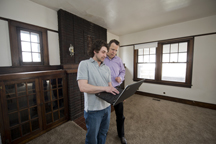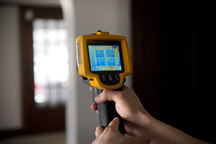Whirlpool Corporation, Purdue turning house into 'net-zero' home
April 24, 2014
 |
|
Purdue doctoral student Stephen Caskey (at left) works with professor Eckhard Groll to convert a home near campus to the most efficient domicile possible - a "net-zero" structure. Purdue is working with Whirlpool Corp. on the three-year project. (Purdue University photo/Mark Simons) |
WEST LAFAYETTE, Ind. - Purdue University is working with Whirlpool Corporation on a three-year project to convert a home near campus to the most efficient domicile possible - a "net-zero" structure.
The home, called the ReNEWW house - for Retrofitted Net-Zero Energy, Water and Waste - will be renovated to install energy- and water-saving features and equipped with solar panels that produce both electricity and hot water. Systems in the home will harvest waste heat from appliances and "gray water" from showers and sinks.
"Net-zero energy means that over a certain time line - usually an entire year where you take an entire cooling and heating season - energy production equals energy consumption," said Eckhard Groll, the Reilly Professor of Mechanical Engineering and director of Purdue's Office of Professional Practice. "It's going to be a super-efficient home."
Researchers and the company will use data collected from the home in the first year for educational purposes and to specify the retrofit measures.
"So much of the net-zero energy discussion now focuses on new buildings," said Groll, who is facilitating the Purdue portion of the project. "But most homes are existing structures."
The United States currently has more than 130 million existing housing units, most of which have been in existence since the 1970s.
 |
|
Doctoral student Stephen Caskey uses an infrared camera in research to improve energy efficiency in the structure. (Purdue University photo/Mark Simons) |
The house, built in the late 1920s and located at 545 Hayes St. in West Lafayette, is owned by the Purdue Research Foundation, which leased the structure to Whirlpool.
Whirlpool engineers will come to Purdue as graduate students and live in the house for two semesters as part of the Whirlpool Engineering Rotational Leadership Development (WERLD) program. Engineers perform four six-month rotations in various groups within the company, including a potential international rotation.
"At the end of that period they come to Purdue for two semesters," Groll said. "Three WERLD master's students will have the opportunity to live in the house and work on projects related to that house, so it becomes a living lab."
The engineers take courses long-distance through Purdue's engineering professional education program while they conduct the six-month rotations so they can finish their master's degree during the two semesters at Purdue.
"I team them up with the appropriate faculty member," Groll said.
During the first year students will collect "baseline data," which includes precision measurements of the structure and how much energy and water it currently consumes.
Baseline data are needed to determine how to upgrade the home by replacing the windows, insulation and appliances and how to add solar panels and other equipment.
"We want to do some major renovations, including implementing thermally integrated appliances during the third year. That means if you have an air conditioner that rejects heat to the outside through a condenser coil, why don't we harvest that heat and put it into the hot-water system?" said Groll, whose research is based at Purdue's Ray W. Herrick Laboratories.
A Purdue doctoral student, Stephen Caskey, also is working on the home for his thesis but does not live there. Students from Purdue's College of Technology also are working to create a three-dimensional model of the home.
Research will enable the company to accelerate the advanced development of next-generation ultra-efficient appliances.
"Whirlpool Corporation-made appliances have achieved dramatic improvements in energy and water efficiency, while improving performance and consumer choice," said Ronald Voglewede, global sustainability lead, at Whirlpool Corporation. "The ReNEWW house will allow Whirlpool Corporation to leverage the world class resources at Purdue University in conjunction with our WERLD program to accelerate the development of the next-generation system of innovative home appliances that offer even more performance without compromise.”
The basement will be finished and converted into a "living laboratory" with equipment and instrumentation necessary for appliance advanced development. Researchers will be able to use the living laboratory to test and validate new building systems and concepts.
"The Whirlpool project is a living lab for the personal environment, whereas the work we're doing at Herrick focuses on the work environment, so they complement each other," Groll said.
Purdue and Whirlpool Corp. have a history of collaboration. The company has for decades worked with researchers based at Herrick to improve the energy efficiency of appliances.
Writer: Emil Venere, 765-494-4709, venere@purdue.edu
Source: Eckhard Groll, 765-494-7430, groll@purdue.edu
Related website:

